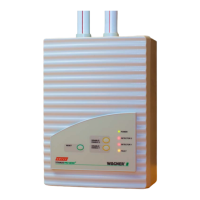
Do you have a question about the Ampac TITANUS PRO·SENS MAN3046 and is the answer not in the manual?
| Brand | Ampac |
|---|---|
| Model | TITANUS PRO·SENS MAN3046 |
| Category | Smoke Alarm |
| Language | English |
Manual for installers, engineers, technicians, and fitters.
Explains symbols for attention, instruction, and tips to avoid damage or ensure smooth operations.
Details system features like sensitivity, LOGIC·SENS, air flow monitoring, patented sampling points, diagnostics, and ventilator voltage.
Lists areas where point-type detectors are unsuitable and specific room types suitable for monitoring.
Outlines basic device and pipe system components, detector modules, aspiration unit, and air flow sensor.
Explains aspiration, detector module operation, LOGIC·SENS, module monitoring, and air flow monitoring.
Lists components of the basic device: housing, connection piece, detector module, air sampling unit, and displays.
Describes using diagnostic software for reading device state, fault signals, and clearing faults.
Details pipe system components like T-pieces, elbows, filters, and sampling points.
Provides technical specifications: voltage, current, dimensions, weight, noise level, protection class, and housing.
Specifies pipe system limits: length, sampling points, temperature range, and monitoring area.
Introduces project planning according to EN54.20/AS7240.20 and lists planning options.
Outlines national regulations and approvals (AS1603.8, EN54.20) relevant to aspirating smoke detectors.
Details pipe system design: symmetrical/asymmetrical layouts, aperture diameters, and standards.
Explains EN54.20 requirements for air flow monitoring, sensitivity adjustment, and dynamic sensor system.
Details fire sensitivity classes (A, B, C) and selectable sensitivity levels for detector modules.
Outlines factors for project planning: sensitivity, aspiration apertures, and accessories.
Details aperture diameters for I-pipe systems based on the number of apertures.
Covers planning for individual aperture monitoring, simplified pipe planning, and long intake lines.
States that regulations from chapter 4.1 apply and outlines general mounting considerations.
Details system settings: detector module sensitivity, alarm delay, air flow monitoring thresholds, and LOGIC·SENS.
Details mounting the system for clear display visibility, wall mounting, and ensuring air outlet is unobstructed.
Outlines steps for preparing electrical connections, attaching connection pieces, and passing cables.
Provides a guide for installing a second detector module, including opening the housing and connecting cables.
Describes using diagnostic software DIAG 3 to read out and save device data, status values, and settings.
Describes the layout of air sampling points, including the 10mm hole and use of aspiration-reducing film sheets.
Details installation of LF-AD-x and SF-400/650 air filters, covering mounting and specific procedures.
Explains mounting detonation prevention devices in explosive areas and emphasizes gas-tight connections and grounding.
Explains the need for device operation before adjustment and describes two adjustment types: independent and dependent on air pressure.
Explains how to trigger the alarm and check transmission to the central fire panel, including troubleshooting.
Details procedures for verifying pipe fracture and blockage detection using diagnostic software and flash codes.
Describes performing operational checks using test pipes and manometers or diagnostic software.
Provides step-by-step instructions for safely exchanging a detector module, including power down and initialization.
Details the procedure for changing LF-AD-x filter inserts, including cleaning the housing and replacing inserts.
Describes checking air flow sensor adjustment using diagnostic software, monitoring current vs. rated values.
Outlines inspection and maintenance intervals (quarterly, annual) and lists checks performed at each interval.
Contains tables for projection based on sensitivity, pipe shape, fan voltage, and accessories.
Defines aerosol as a floating particle in the microscopic or submicroscopic range.
Sensor for monitoring total air flow in the pipe system for blockage and fracture.
Active system using a ventilator to take air samples passed to a detection unit.
Acoustic/optical signal indicating fire, or a freely adjustable alarm threshold.
